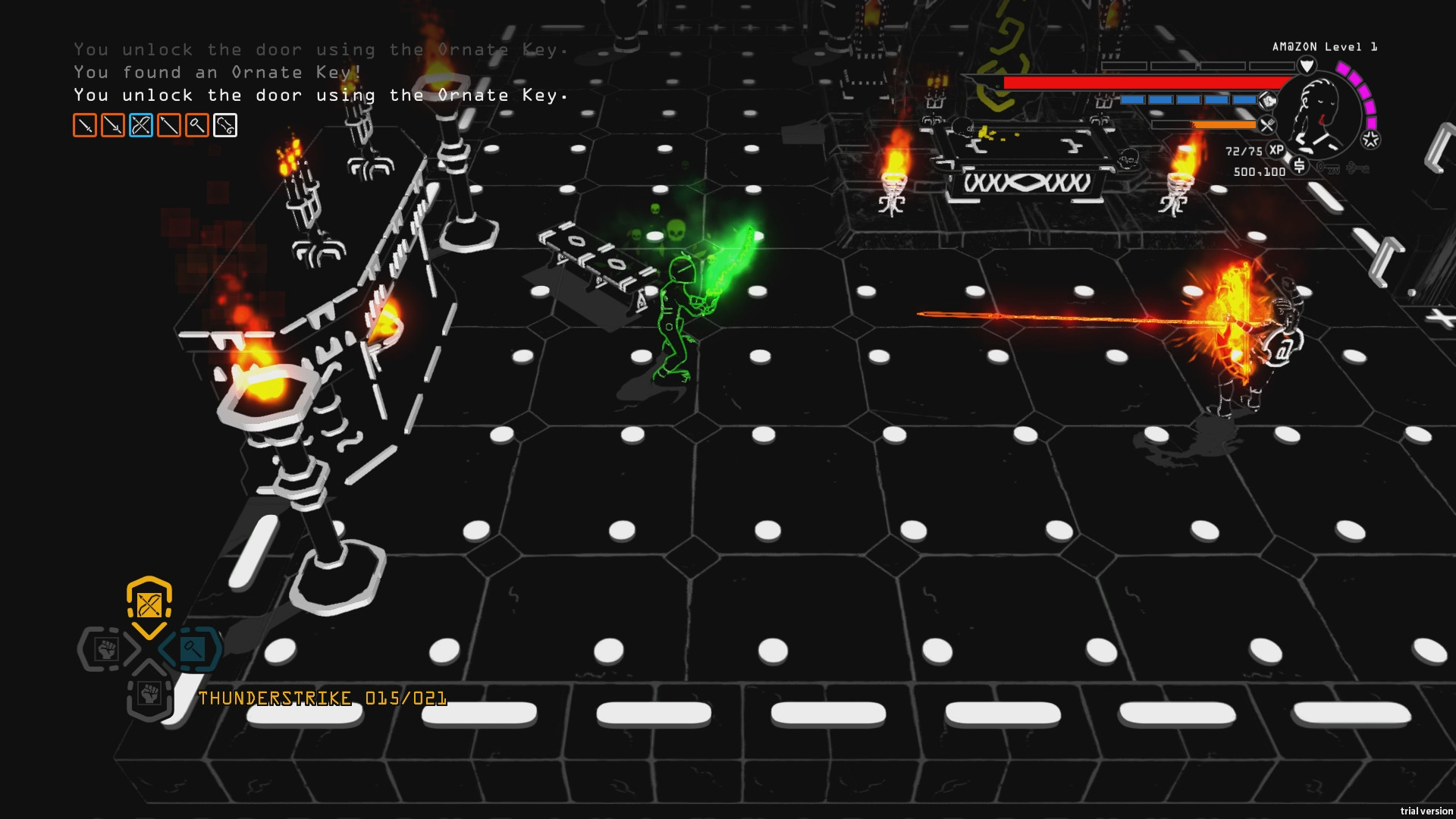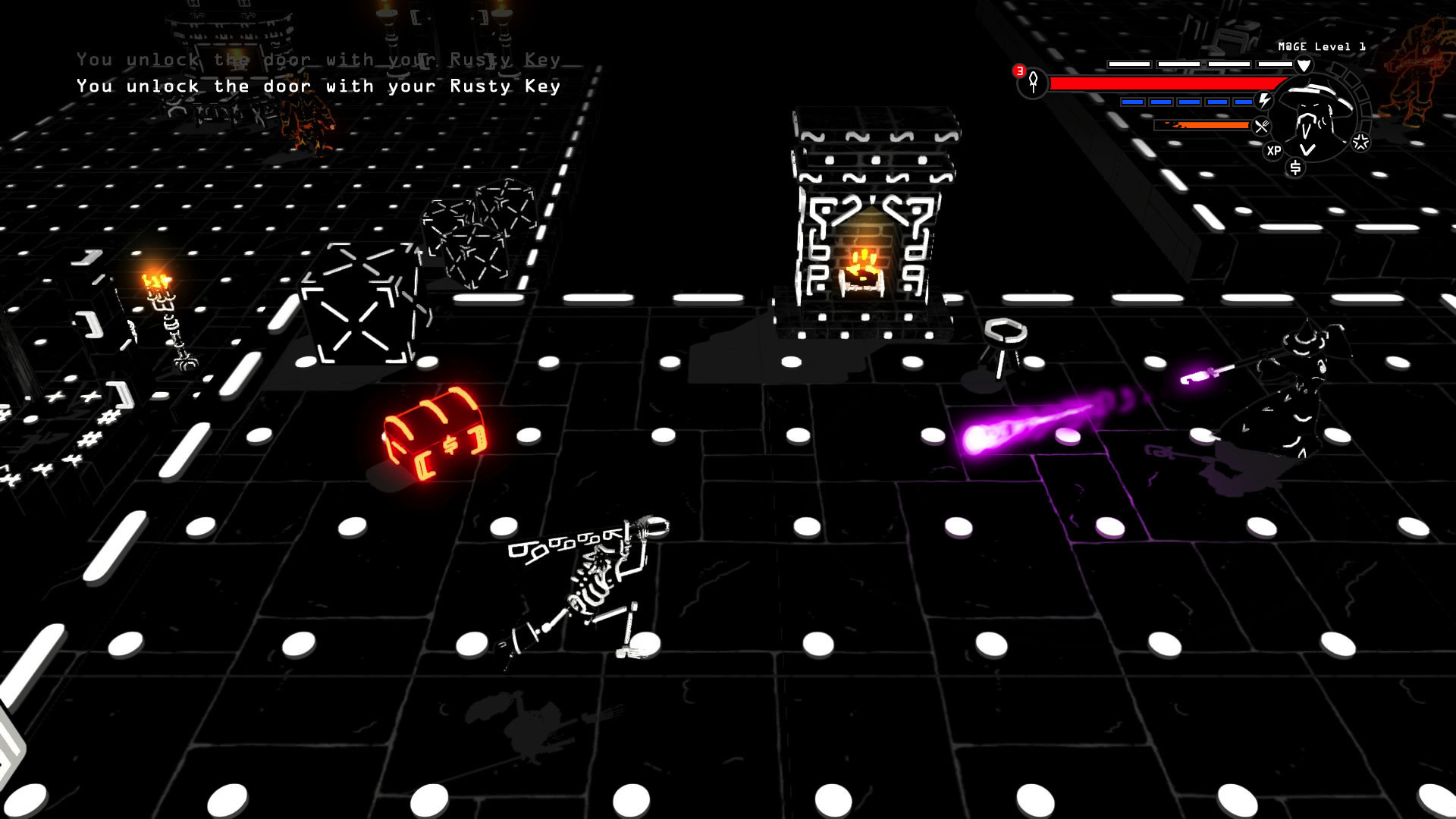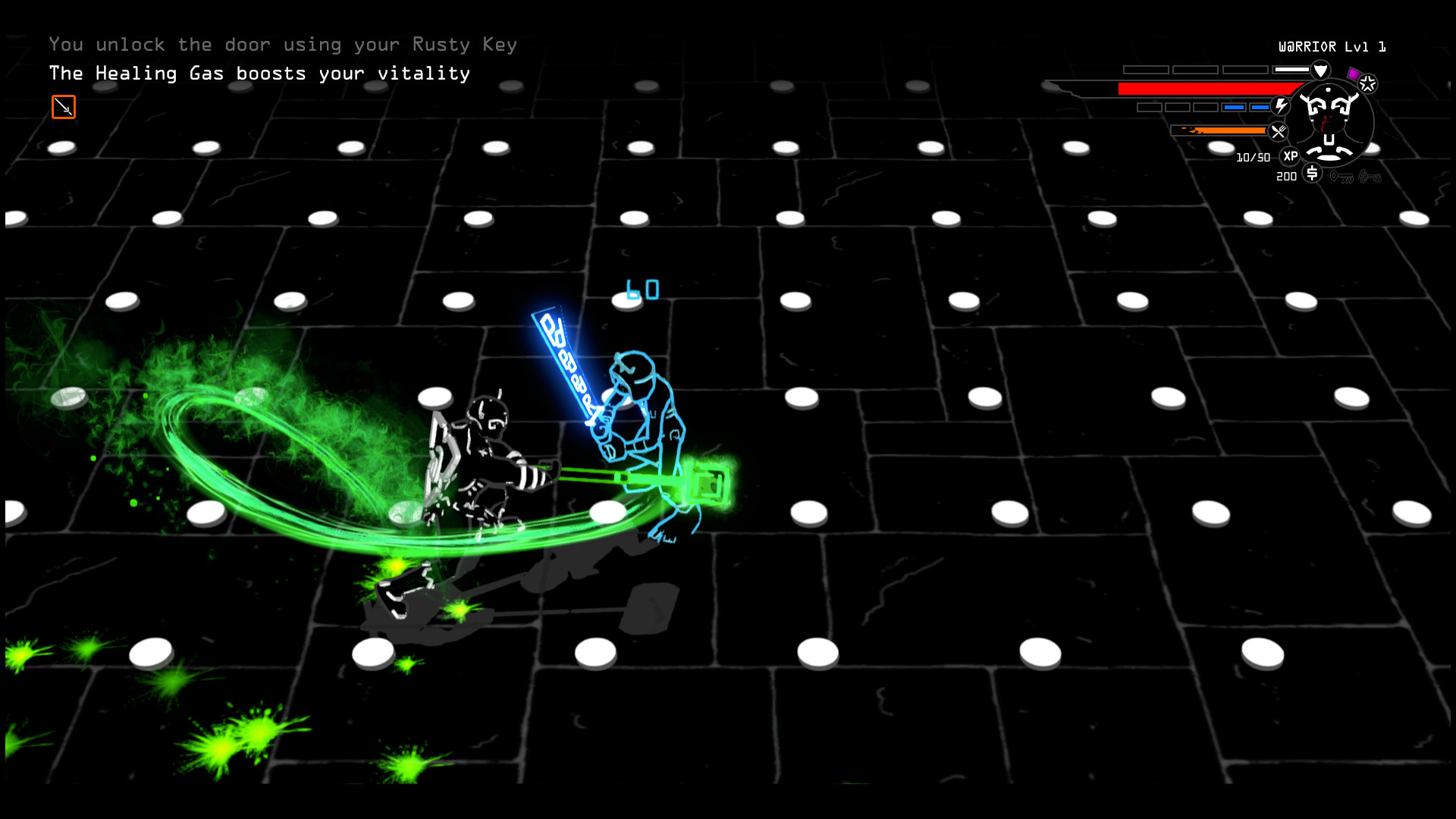 Brut@l is a top-down dungeon crawler that pitches itself as a love letter to old ASCII Roguelikes, but with modern mechanics and graphics. In practical terms, it’s a fairly basic hack ‘n slash with permadeath, procedurally generated rooms, and a charming aesthetic where everything is made of ASCII symbols. As a fan of Roguelikes/lites, I was looking forward to Brut@l. It’s a new entry in a genre I really enjoy, and it features rather striking visuals. Unfortunately, Brut@l’s presentation is the only thing it really has going for it.
Brut@l is a top-down dungeon crawler that pitches itself as a love letter to old ASCII Roguelikes, but with modern mechanics and graphics. In practical terms, it’s a fairly basic hack ‘n slash with permadeath, procedurally generated rooms, and a charming aesthetic where everything is made of ASCII symbols. As a fan of Roguelikes/lites, I was looking forward to Brut@l. It’s a new entry in a genre I really enjoy, and it features rather striking visuals. Unfortunately, Brut@l’s presentation is the only thing it really has going for it.
You start a dungeon run by choosing from one of four classes. This is your first warning that the game you are about to play is fairly bland and uninteresting, as each class really isn’t all that different. They have different health totals and starting skills, but they all start with the same inventory of a battered shield and unlit torch. Each class even has the same skill trees, though calling them “trees” is charitable. In reality, its four linear paths of six skills each, and most of them are just passives that let you equip certain items or craft more complex gear. The only truly unique class is the Mage, who comes with a magic bolt attack that recharges every few seconds.
The goal of any given run is to conquer all 26 procedurally generated floors. Each floor consists of a dozen or so rooms and can be cleared in about 8 to 12 minutes, depending on how devoted you are to exploring everything and finding secrets. Most of the rooms are fairly straightforward, often containing a group of monsters to slay and maybe a sprinkling of traps or explosive barrels to watch out for. Sometimes you’ll encounter a maze room, or extremely rudimentary “puzzles” where you must hit the right lever to open a cage containing loot.
The most infuriating rooms have acid or fire coating the floors. Such rooms serve only as a cheap way to eat up some of your precious health, because there is no way to avoid taking damage as you run through them outside of a Potion of Protection. You’ll occasionally encounter floating platforms with instant death bottomless pits. These extremely basic platforming sections can also be pretty frustrating and accounted for most of my deaths. Between the graphics style and camera angle, these bottomless pits can occasionally be a bit difficult to see at first glance.
 Pretty much every room is full of barrels and other objects that can be smashed for a small amount of experience and the possibility of loot. This loot could be gold, crafting materials, food, ASCII runes, weapon codices, or armor. Outside of limited use wands, you’ll never find an actual weapon, only recipes that allow you to forge one out of ASCII runes. This makes the early floors particularly boring, as you’ll probably be stuck with your bare hands until you find a weapon codex and all the ASCII symbols you need to craft it.
Pretty much every room is full of barrels and other objects that can be smashed for a small amount of experience and the possibility of loot. This loot could be gold, crafting materials, food, ASCII runes, weapon codices, or armor. Outside of limited use wands, you’ll never find an actual weapon, only recipes that allow you to forge one out of ASCII runes. This makes the early floors particularly boring, as you’ll probably be stuck with your bare hands until you find a weapon codex and all the ASCII symbols you need to craft it.
Things don’t actually get much better once you have a weapon, because they are all pretty boring. Weapons come in several classes, like swords, polearms, bows, and hammers. In general, swords have average attack speed and reach, polearms have the most reach, and hammers are slower, but have the added benefit of being able to smash weak walls to access secret rooms. As you delve deeper into the dungeon you’ll find weapons that do slightly more damage, but are otherwise identical to lower tier weapons.
Enchanting makes combat a bit more interesting. Throughout the dungeon you’ll find special ASCII symbols that can be used to imbue your weapons with elemental effects, like fire, poison, electricity, arcane energies, ice, etc. These elements add a minor damage-over-time effect to your weapons, and some elements have extra powers, like how ice can freeze enemies, or arcane has a chance to transmogrify them into weaker foes.

You’ll encounter enemies with elemental types too, but oddly enough there are no elemental weaknesses or strengths as far as I can tell. Feel free to murder a fire enemy with your flaming sword, it doesn’t seem to actually matter. The exception are zombies, which can only be killed with a fire weapon or a lit torch. Sometimes you’ll encounter doors or chests that can only be opened by hitting them with specific elemental weapons, but in general elemental items do nothing besides give you a slight edge in combat.
There’s some other crafting elements as well, most notably potions. There are 8 potions total, each of which are a different color. These colors are randomized each run, so you’ll need to experiment every game to figure them out. This can be done either by drinking it or throwing it on an enemy. Potions have a variety of effects, and can heal you, cause damage to restore health, turn you invisible, or cause you to rapidly spin and deal damage to anything you come into contact with. The potion brewing is just as basic as Brut@l’s other mechanics, with each color of potion requiring two items and an empty bottle to make.
“Basic” sums up Brut@l in general. Combat involves little more than a standard three-hit combo system for melee weapons. Defensive moves come in the form of your shield and an extremely finicky dodge roll. Blocking reduces damage, while a well-timed parry negates all damage and leaves the enemy open to a counterattack. The dodge move requires such an awkward combination of buttons that you are better off just double jumping over enemies to avoid them. Besides, most enemies spend so long telegraphing their attacks that you could complete a round-trip flight from New York to Japan before they are finished with their swing.
 Each skill tree has a super move you can learn that gradually charges over time. These super moves require a specific type of weapon be equipped before you can perform it, but they all do pretty much the same thing. No matter what the move is called, the end result is always just dealing massive damage to enemies within a certain radius around you.
Each skill tree has a super move you can learn that gradually charges over time. These super moves require a specific type of weapon be equipped before you can perform it, but they all do pretty much the same thing. No matter what the move is called, the end result is always just dealing massive damage to enemies within a certain radius around you.
You can throw your shield as a basic ranged attack, and there are some dedicated ranged weapons like bows and wands. The controls on keyboard and mouse are pretty bad, so you better bring a controller on this adventure. Of course, the problem with bringing a controller is that it makes aiming at specific enemies in a large mob rather difficult. In general though, I found that ranged combat wasn’t too viable most of the time because of how fast many of the enemies are and the complete lack of defensible positions in most rooms. The enemies that are slow enough to be kitted and taken out at range have so much health and armor that it just isn’t really worth it.
Brut@l’s other big fault is that it just doesn’t feel particularly rewarding. In a bizarre inverse of genre norms, loot seems to become increasingly scarce the deeper you go. Within the first 8 floors you’ll probably find more weapons than you’ll ever actually need, while later on you can go several floors without finding anything noteworthy. Even when you do find new weapons, they’ll often function the same as what you already have, just with slightly higher damage. Armor is even more bland. There aren’t multiple classes of armor, and you won’t find armor with cool passive bonuses or anything like that. There is just a single chest piece, a single helmet, a single pair of gauntlets, and a single pair of greaves, and all they do is reduce damage by a set amount until they eventually break.
“Loot,” which is just a generic term for “money” in this game, only has one function. You’ll occasionally stumble across altars that you can donate money to for the chance of gaining an extra life. The amount of money you donate increases your chances, but it’s still just random chance. There’s nothing wrong with that, indeed the genre is built off of random chance, but it’s disappointing that this is the only thing you can do with money. There are no shops or places to spend money for items, just these life altars.
 The bland loot and increasing difficulty create a situation where you aren’t really rewarded for going deeper into the dungeon. The only reason you keep going is because, well, that’s the point of the game. You are supposed to see if you can survive all 26 floors, but there isn’t anything interesting on those floors to keep you going. In fact, as I said a few paragraphs back, the loot becomes more scarce the deeper you go. The enemies, however, only become bigger, stronger, and more bullet (Sword? Arrow?) spongy. Why should I keep playing if all I’m faced with are stronger enemies, but no increasingly cool rewards? It’s all risk with no really payoff.
The bland loot and increasing difficulty create a situation where you aren’t really rewarded for going deeper into the dungeon. The only reason you keep going is because, well, that’s the point of the game. You are supposed to see if you can survive all 26 floors, but there isn’t anything interesting on those floors to keep you going. In fact, as I said a few paragraphs back, the loot becomes more scarce the deeper you go. The enemies, however, only become bigger, stronger, and more bullet (Sword? Arrow?) spongy. Why should I keep playing if all I’m faced with are stronger enemies, but no increasingly cool rewards? It’s all risk with no really payoff.
Despite all the bad points I’ve brought up in this review, I don’t think Brut@l is an awful game. It has the foundations of a pretty cool dungeon crawler, and I love the art style. Brut@l’s biggest problem is that it’s a generic, bland, and extremely basic game in a genre flooded with really good titles. Heart&Slash is a similar dungeon crawler with a basic combat system, but it has a ton of cool and interesting weapons to compensate for its basic mechanics. I can’t help but feel that Brut@l came out about 4 or 5 years too late. Had it released before the Roguelite genre saw a boom in popularity from titles like The Binding of Isaac, then I may have been more forgiving on it. As a game that came out in 2017 (Late 2016 on PS4), however, Brut@l is competing with dozens of other games that do the same thing it does, only much better.
I’ve put about 10 hours into Brut@l and got roughly halfway through on my best run, but I have no interest in playing more or trying to beat it. There just isn’t enough content or unique items to motivate me to play more. In Enter the Gungeon I can find a bullet that shoots guns that shoot bullets. In Brut@l, I can find a pike that does 5 more damage than my current pike. Brut@l could be a good game if it just had more to it, but not now and not at the current price tag. You can find Brut@l on Steam, Humble Bundle, and PS4 for $14.99.
